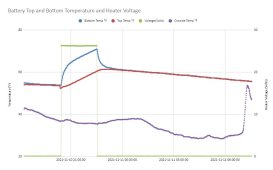Horsefly
Solar Wizard
Yes I tend to agree. I have a 8S 24v pack, and 2 12V, 12W heaters in series, so a total of 24W, drawing a bit over an amp from my battery when on. I have another two of the same heaters, and was thinking if I had to I would add them in parallel to the other two, for a total of 48W.From one of the comments on there: " They each draw 3.5 amps at 12.3v or 43 watts" - it's a bit much. Personally I prefer something lower power so the battery temperature changes more gradually. A battery has a lot of thermal mass, and you want to make sure the cells get enough time to properly warm up. With too much heating power, this will be harder to control.
I'm continuing to run experiments here. A few nights ago the outside temps got down to about 28°F. I put my battery box out in the driveway and turned on the logging all night.

The main thermostat on the batteries was set to turn on at 50°F and turn back off at 60°F. The green line shows when the heater was running, which was from basically 8:26pm to 10:31pm. (Excuse the blip in the temp measurements right as it started to heat: I had taken the lid off the box to check something and forgot about it for a few minutes. Came back to find the heater on, and I put the lid back on the box.) As you can see, the aluminum plate under the cells heated up pretty quickly (blue line) but then heated up linearly, topping out at 71°F. The top of the cells heated up linearly, and - as might be expected - continued to heat after the heater was turned off at 60°F as the heat from the bottom migrated up to the top. From 10:51pm to 7:33am the next morning (a bit over 8.5 hrs) there was no additional heat and the temp of the cells only dropped a bit over 6°F before I stopped the experiment.
So I expended about 2.5Ah as the heater ran for about 2 hours, which was enough for the whole night. This has me convinced that I don't need to add the other two heaters. 24W should be plenty.


